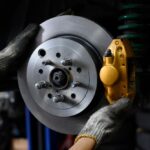For car owners and automotive enthusiasts alike, understanding the health of your vehicle is paramount. Gone are the days of blindly guessing what’s wrong when that dreaded check engine light illuminates. Today, with the advent of Obd Ii Diagnostic Scanners, accessing your car’s onboard computer and deciphering potential issues is easier and more affordable than ever. These powerful tools provide a direct line of communication to your vehicle, empowering you with the knowledge to make informed decisions about maintenance and repairs.
Why Every Car Owner Needs an OBD II Diagnostic Scanner
Modern vehicles are complex machines, relying heavily on electronic control units (ECUs) and sensors to manage everything from engine performance to safety systems. When something goes amiss, your car’s computer often stores diagnostic trouble codes (DTCs) that pinpoint the source of the problem. This is where an OBD II diagnostic scanner becomes indispensable.
An OBD II scanner, also known as an OBD2 scanner or car diagnostic tool, is an electronic device used to interface with your vehicle’s On-Board Diagnostics system. Since the mid-1990s, OBD-II has been standardized across most vehicles, making these scanners universally compatible. But what exactly can an OBD II diagnostic scanner do for you?
-
Diagnose Check Engine Light Issues: The most common use is to read and clear “check engine light” codes. Instead of immediately rushing to a mechanic, you can use your OBD II scanner to identify the problem yourself. Is it a loose gas cap, a faulty sensor, or something more serious? Knowing the DTC provides valuable insight.
-
Save Money on Repairs: By understanding the issue beforehand, you can avoid unnecessary trips to the mechanic and potentially perform simple fixes yourself. For more complex problems, knowing the DTC allows you to have an informed conversation with your mechanic, preventing misdiagnosis and costly repairs.
-
Monitor Vehicle Health: Beyond just error codes, many OBD II scanners can display real-time data about your vehicle’s performance. This “live data” can include engine temperature, RPM, oxygen sensor readings, and much more. Monitoring these parameters can help you detect potential problems early, even before the check engine light comes on.
-
Pre-Purchase Inspections: Considering buying a used car? An OBD II diagnostic scanner is an essential tool for pre-purchase inspections. Quickly scan the vehicle for stored codes that the seller may not have disclosed. This can reveal hidden issues and save you from buying a car with underlying problems.
Choosing the Right OBD II Diagnostic Scanner
The market for OBD II diagnostic scanners is vast, ranging from basic code readers to advanced professional-grade tools. Selecting the right scanner depends on your needs and budget.
-
Basic Code Readers: These are the most affordable and user-friendly options. They typically read and clear DTCs, making them ideal for DIYers who primarily want to diagnose check engine light issues.
-
Mid-Range Scanners: These scanners offer more advanced features, such as live data streaming, graphing, and sometimes basic actuation tests. They are a good choice for more serious DIYers and hobbyist mechanics.
-
Professional Diagnostic Scanners: These are the most comprehensive and expensive scanners, often used by professional mechanics. They offer advanced functions like bi-directional control, module programming, and access to manufacturer-specific diagnostic information. Brands like Autel are renowned for their professional-grade OBD II diagnostic scanners.
Consider these factors when choosing an OBD II diagnostic scanner:
- Features: Do you need basic code reading, live data, or advanced functions?
- Vehicle Compatibility: While OBD-II is standardized, some scanners offer enhanced coverage for specific makes and models.
- Ease of Use: Look for a scanner with an intuitive interface and clear instructions.
- Budget: Scanners range in price from under $50 to thousands of dollars. Determine how much you are willing to spend.
Beyond Code Reading: Exploring Advanced OBD II Scanner Capabilities
While reading and clearing codes is the primary function, modern OBD II diagnostic scanners offer a wealth of additional capabilities. Many advanced scanners can perform:
- ABS and SRS Diagnostics: Diagnose issues with your anti-lock braking system (ABS) and supplemental restraint system (SRS or airbags).
- Transmission Diagnostics: Access transmission control module (TCM) data and codes.
- Oil Reset and Service Reminders: Reset oil life monitors and other service reminders.
- Battery Registration: Register new batteries in vehicles with battery management systems.
- EPB (Electronic Parking Brake) Service: Retract electronic parking brakes for brake service.
These advanced features, often found in mid-range and professional OBD II diagnostic scanners, provide even greater diagnostic power and functionality, making them invaluable tools for comprehensive vehicle maintenance.
Conclusion: Empower Yourself with OBD II Technology
Investing in an OBD II diagnostic scanner is an investment in your vehicle’s health and your peace of mind. Whether you’re a seasoned mechanic or a first-time car owner, understanding your car’s diagnostic data is crucial for proactive maintenance and cost-effective repairs. By choosing the right OBD II scanner for your needs, you can unlock your car’s secrets, stay informed about its condition, and drive with confidence. Explore our wide selection of OBD II diagnostic scanners today and take control of your automotive diagnostics journey!


